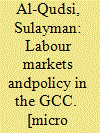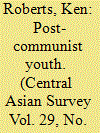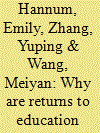|
|
|
Sort Order |
|
|
|
Items / Page
|
|
|
|
|
|
|
| Srl | Item |
| 1 |
ID:
145552


|
|
|
|
|
| Summary/Abstract |
Employment and labour market regulation initially appeared as one of the solid red lines in the UK's renegotiation of the country's place in the EU. The basic argument is that the UK's more deregulated labour market would sit uneasily in the more organised models, based on statutory instruments or collective bargaining, found on the continent. While there is a legitimate problem here, EU employment regulations appear manageable from the point of view of business, while unions see them as important tools for socially responsible economic restructuring. Most of UK employment case law is now deeply entangled with EU law; labour market regulations have, on the whole, become part of the way of doing business in the Single Market; and a simple cost–benefit analysis appears impossible because some costs are not quantifiable and the costs of others are reduced when taken as a bundle. Labour unions agree that transposition of European law needs to be done taking into account local sensitivities, while internationally oriented companies do not see EU regulations on the whole as detrimental to business. Importantly, though, the costs and benefits of EU employment regulations are not symmetrically distributed across different companies: large companies are better able to reap the rewards and accommodate the costs of operating in the Single Market than smaller companies.
|
|
|
|
|
|
|
|
|
|
|
|
|
|
|
|
| 2 |
ID:
000993


|
|
|
|
|
| Publication |
Abu Dhabi, The Emirates Center fro Strategic Studies and Research, 1998.
|
| Description |
40p.
|
| Series |
Emirates lecture,12
|
|
|
|
|
|
|
|
|
|
|
|
Copies: C:1/I:0,R:0,Q:0
Circulation
| Accession# | Call# | Current Location | Status | Policy | Location |
| 040473 | 331.12/AL-Q 040473 | Main | On Shelf | General | |
|
|
|
|
| 3 |
ID:
101302


|
|
|
|
|
| Publication |
2010.
|
| Summary/Abstract |
This article argues that Central Asian youth share more commonalities than differences vis-agrave-vis young people in other ex-Communist countries. The common features include high rates of unemployment and under-employment, associated poverty and a propensity to become pendulum migrants. Meanwhile, as elsewhere, rates of participation in higher education have risen spectacularly in parts of Central Asia. Central Asia has been part of a global trend towards later marriages and lower rates of fertility, although the region's young people still tend to marry earlier and parent more children than in other parts of the ex-USSR. As elsewhere, Central Asian youth have lost most of the provisions for leisure activities formerly offered by state and Communist Party organizations. These have been replaced by relatively patchy provisions by NGOs, and commercial facilities that are beyond the means of most young people. The article argues that the most distinctive feature of youth in Central Asia is citizenship in newly independent states with no prior history of statehood, hence their difficulties in achieving a collective identity. This has created a metaphorical market place in identities. What young people share with youth throughout East-Central Europe and Eurasia is a dominant personal aspiration; namely, to join their countries' new middle classes.
|
|
|
|
|
|
|
|
|
|
|
|
|
|
|
|
| 4 |
ID:
123150


|
|
|
| 5 |
ID:
124643


|
|
|
|
|
| Publication |
2013.
|
| Summary/Abstract |
It is well established that returns on education are higher for women than for men in urban China. We argue that this finding, while accurate, is misleading owing to its individualist perspective. The income to which most working-age women and men have access includes not only their own income, but also spouse income. Furthermore, decisions about participation and investment in the labour force, both consequential for income trajectories, are likely to be made with partner income and potential income in mind. To our knowledge, no research in China has explored the returns to education enjoyed via spouse income, or the implications of pooling couple income, for illuminating the returns to schooling difference for women and men. In this article, using data from the China Urban Labour Survey (2001), we argue that the returns for women, conventionally defined, are higher than for men because many women trade their own income for spouse income, and this is particularly true among less educated women. We demonstrate, first, that women who are more educated are less likely to get married, while the reverse is true for men. Second, we show that among couples there is evidence of a trade-off in investments in careers. Moreover, among couples, the less educated the woman and the more educated the man, the less likely the couple is to depend heavily on her income. Finally, we show that among couples there is a compensating reverse pattern of returns differences by sex when income is conceptualized as spouse income. Thus, in terms of total couple income, there are no returns differences by sex.
|
|
|
|
|
|
|
|
|
|
|
|
|
|
|
|
|
|
|
|
|